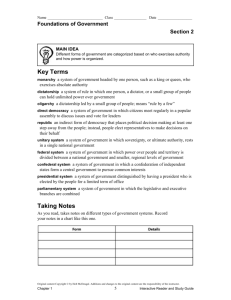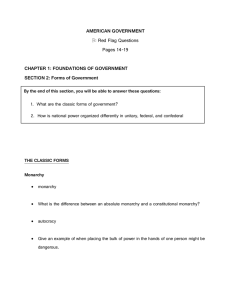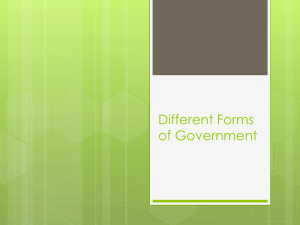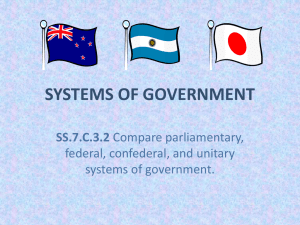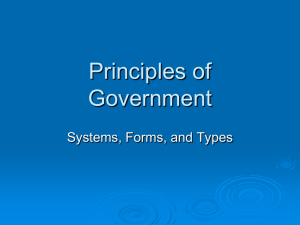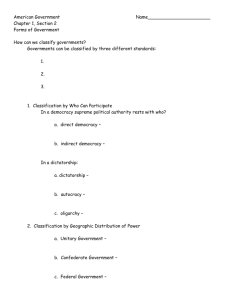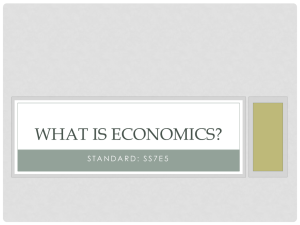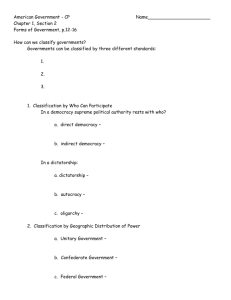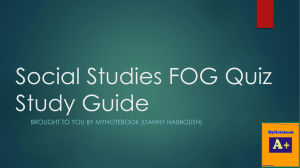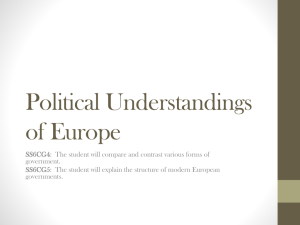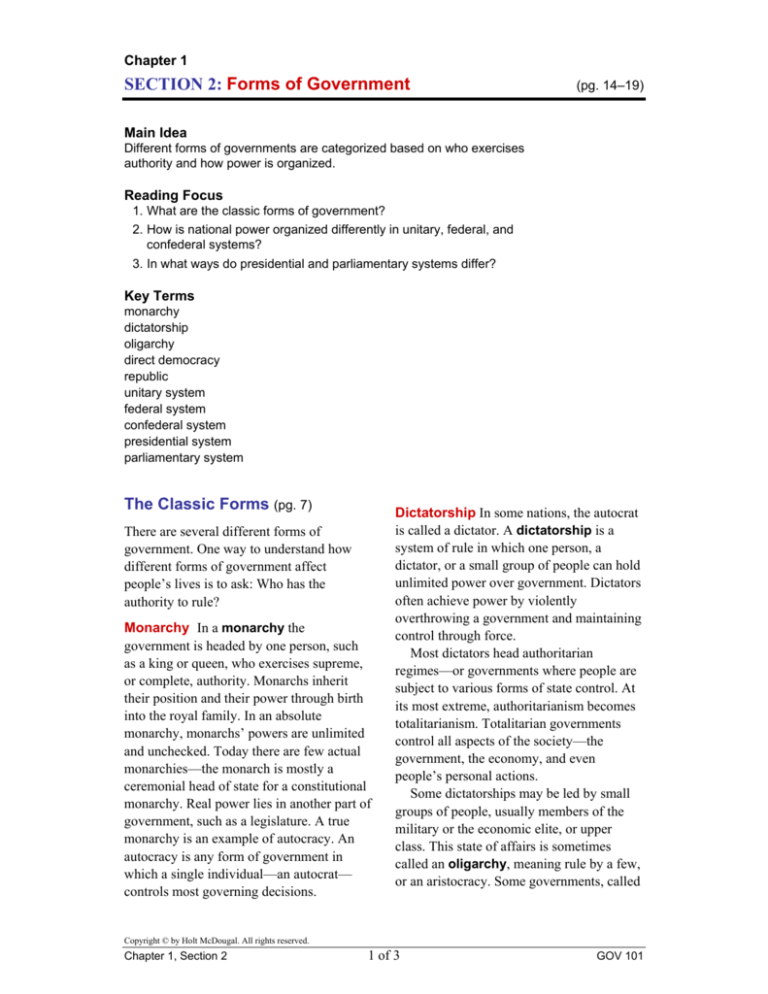
Chapter 1
SECTION 2: Forms of Government
(pg. 14–19)
Main Idea
Different forms of governments are categorized based on who exercises
authority and how power is organized.
Reading Focus
1. What are the classic forms of government?
2. How is national power organized differently in unitary, federal, and
confederal systems?
3. In what ways do presidential and parliamentary systems differ?
Key Terms
monarchy
dictatorship
oligarchy
direct democracy
republic
unitary system
federal system
confederal system
presidential system
parliamentary system
The Classic Forms (pg. 7)
There are several different forms of
government. One way to understand how
different forms of government affect
people’s lives is to ask: Who has the
authority to rule?
Monarchy In a monarchy the
government is headed by one person, such
as a king or queen, who exercises supreme,
or complete, authority. Monarchs inherit
their position and their power through birth
into the royal family. In an absolute
monarchy, monarchs’ powers are unlimited
and unchecked. Today there are few actual
monarchies—the monarch is mostly a
ceremonial head of state for a constitutional
monarchy. Real power lies in another part of
government, such as a legislature. A true
monarchy is an example of autocracy. An
autocracy is any form of government in
which a single individual—an autocrat—
controls most governing decisions.
Dictatorship In some nations, the autocrat
is called a dictator. A dictatorship is a
system of rule in which one person, a
dictator, or a small group of people can hold
unlimited power over government. Dictators
often achieve power by violently
overthrowing a government and maintaining
control through force.
Most dictators head authoritarian
regimes—or governments where people are
subject to various forms of state control. At
its most extreme, authoritarianism becomes
totalitarianism. Totalitarian governments
control all aspects of the society—the
government, the economy, and even
people’s personal actions.
Some dictatorships may be led by small
groups of people, usually members of the
military or the economic elite, or upper
class. This state of affairs is sometimes
called an oligarchy, meaning rule by a few,
or an aristocracy. Some governments, called
Copyright © by Holt McDougal. All rights reserved.
Chapter 1, Section 2
1 of 3
GOV 101
Chapter 1, Section 2 continued
theocracies, are under the rule of a small
group of religious leaders.
Democracy The term democracy means
“rule by the people.” In a pure democracy,
the people make major government
decisions through a process of majority rule.
Such was the state of affairs in Athens and
other ancient Greek city-states. Athenian
democracy was a direct democracy.
Citizens—a small fraction of the male
population—met regularly in a popular
assembly to discuss issues and vote for
leaders.
Direct democracy works best in small
communities. For this reason, most of the
world’s democracies—the United States
included—are republics. A republic is an
indirect form of democracy that places
political decision making at least one step
away from the people. In a republic, the
people elect representatives to make
decisions on their behalf.
territory between a national government and
smaller, regional levels of government. As it
exists today, the federal system is largely an
American invention. The U.S. federal
system is made up of two levels—a central
national government and 50 state
governments. Both levels can make laws,
elect officials, and create agencies.
Confederal Systems In a confederal
system independent states join forces by
forming a central government, called a
confederation. The states keep full control
over their own territories and people. The
states delegate limited powers to a central
government to pursue common areas of
interest.
Reading Check Comparing How is
power divided in federal, unitary, and
confederal systems?
Presidents and Parliaments (pg.
18–19)
Reading Check Identifying the Main
Idea What are the classic forms of
government?
Today most governments have adopted
some form of democratic government. These
democracies fall into two types of political
systems—presidential and parliamentary.
Organizing National Power (pg.
17–18)
Most national governments are made up of a
number of small administrative, or
governing units. There are several different
ways in which power can be organized
across these units.
Unitary Systems The vast majority of the
world’s nations have unitary systems of
government. In a unitary system,
sovereignty, or ultimate authority, rests in a
single, national government. In unitary
systems, local government may be
important, but the national government has
the ultimate authority.
Federal Systems A federal system of
government divides power over people and
Presidential Systems Many of the
world’s governments are modeled after the
presidential system of the United States. In
general, a presidential system is
distinguished by having a president that is
elected by the people for a limited term of
office. The president is in charge of the
executive branch of the government. He or
she may appoint cabinet members to oversee
other government functions. The president’s
powers are balanced by a legislature that is
popularly elected and independent of the
president. Drawbacks of such a system
include when the president and Congress
hold opposing views, causing a situation in
which little is accomplished.
Copyright © by Holt McDougal. All rights reserved.
Chapter 1, Section 2
2 of 3
GOV 101
Chapter 1, Section 2 continued
Parliamentary Systems Most of the
world’s democracies, by contrast, are
modeled after the British parliamentary
system. In a parliamentary system, the
executive and legislative branches of
government are combined. Instead of a
president, parliamentary systems have a
prime minister, who is chosen by and from
an elected legislature called parliament.
Combining the executive and legislative
branches make it easier to pass laws, but
prime ministers are not elected by the people
nor are they able to take a stand against
parliament.
Reading Check Contrasting How does
electing a president differ from electing a
prime minister?
SECTION 2 ASSESSMENT
1. Describe What is a monarchy?
2. Identify How is power organized in a unitary system?
3. Describe What are the possible disadvantages of a presidential system?
Copyright © by Holt McDougal. All rights reserved.
Chapter 1, Section 2
3 of 3
GOV 101

